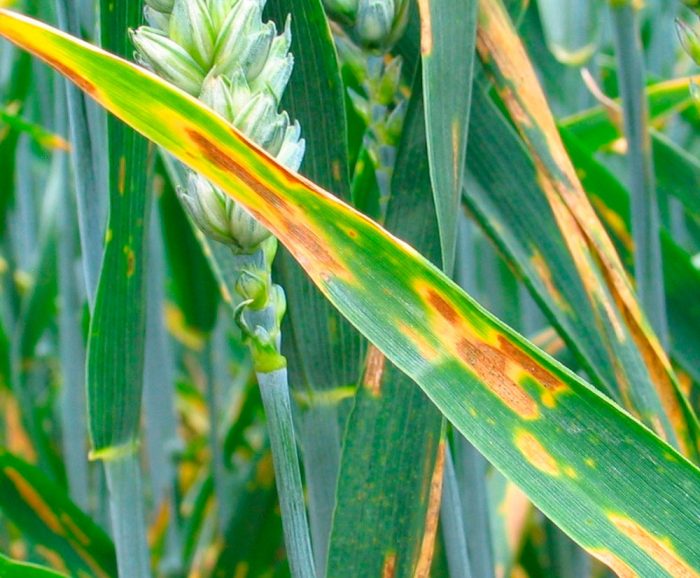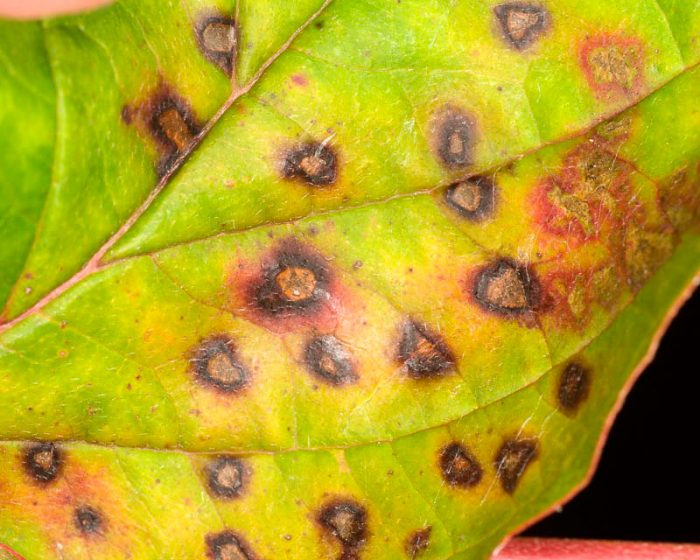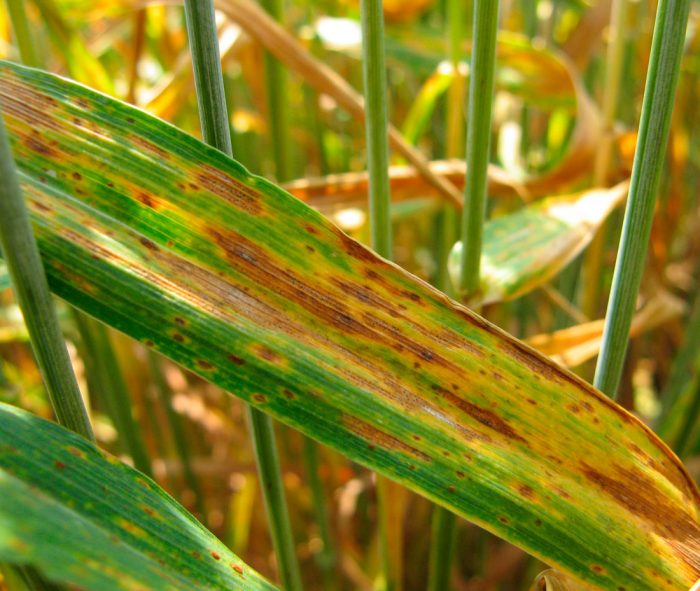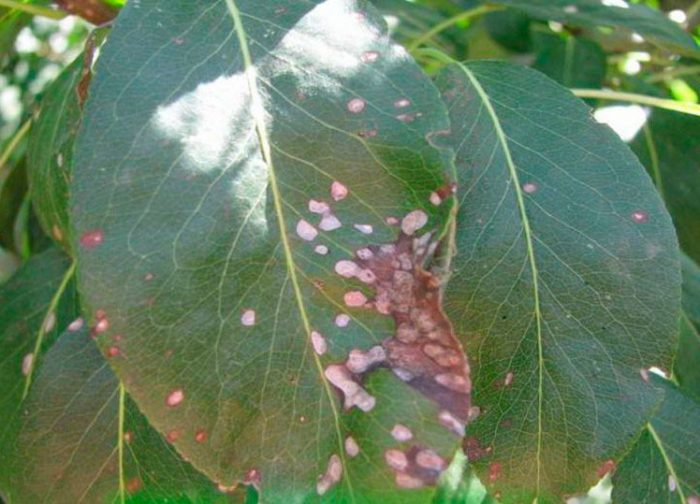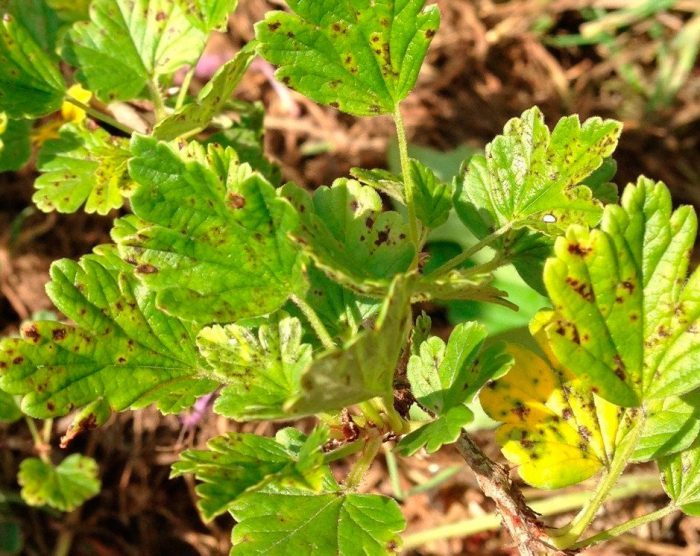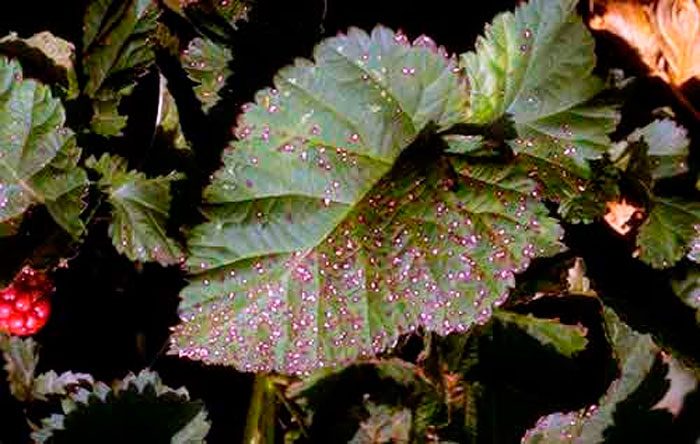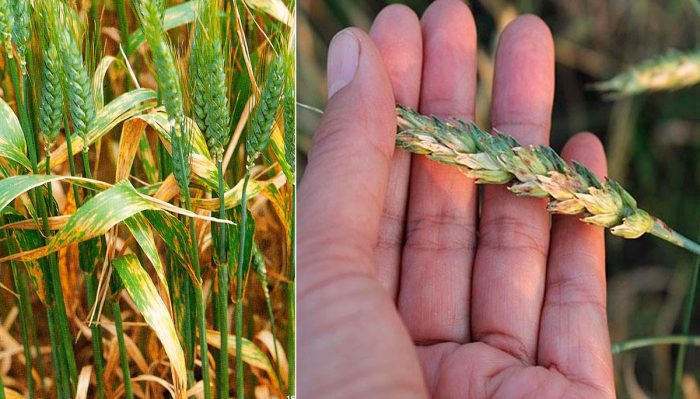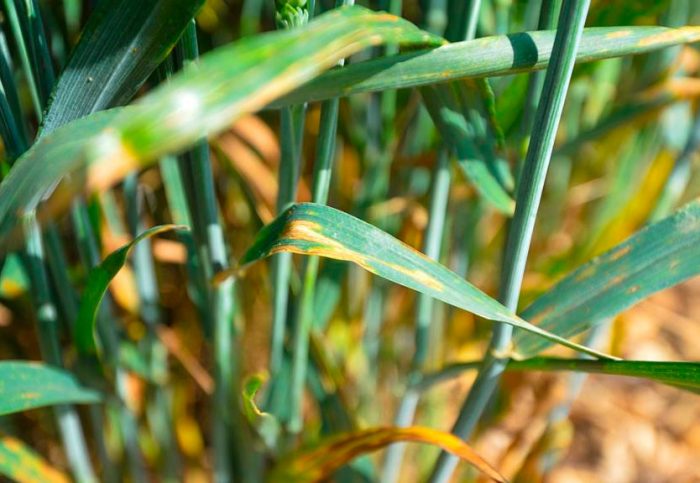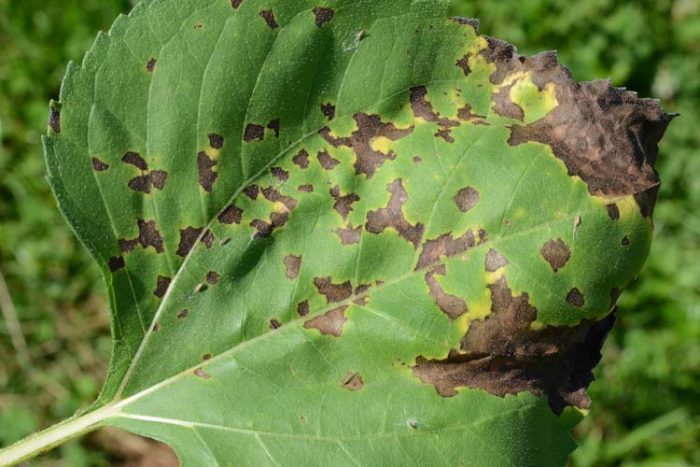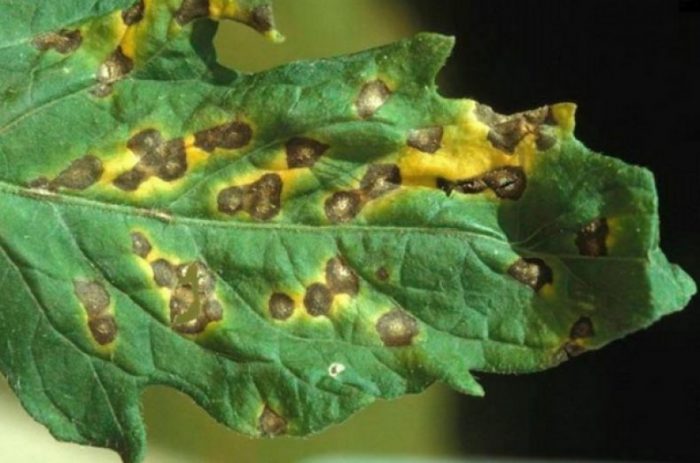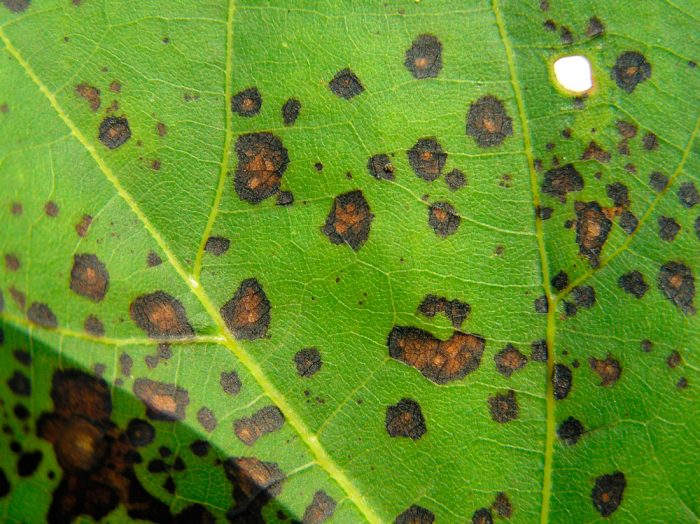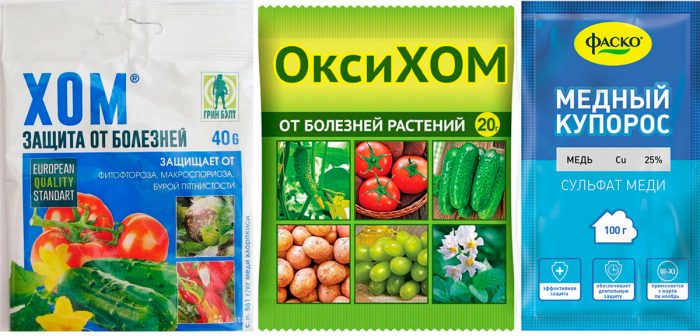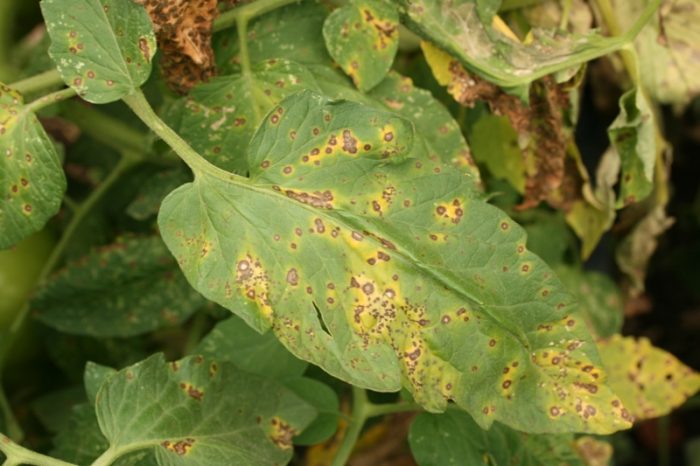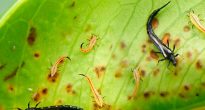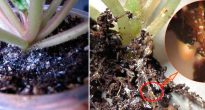Septoria, also called white spot, is one of the most common diseases. It affects both wild plants and various crops. On the surface of the leaf plates of the affected plant, specks of light color with a dark border are formed.
Content
Features of septoria
Septoria is a fungal disease, and fungi of the genus Septoria are considered its causative agent. Very often, this disease, which is caused by the fungi Septoria graminum, Septoria tritici and Septoria nodorum, affects crops belonging to the cereal family, with both Septoria blight of spring and Septoria blight of winter crops. Currants and gooseberries are affected by the fungus Septoria ribis, and tomatoes by Septoria lycopersici. It is also known about the existence of hemp septoria, white spot of soybeans, grape septoria and many other crops. Root crops (white spot of carrots) are also affected by this disease, as well as ornamental crops, for example, septoria phlox grown in the garden, and white spot of anthurium, cultivated at home.
The first symptom of this fungal disease is the specks that form on the surface of the leaf blades. As a rule, they have a light color with a darker border, but you can also find yellow or brownish formations, and the border can be colored yellow. As the disease progresses, the spots increase in size and are connected to each other, occupying almost the entire surface of the leaf, while in their middle points of black pycnidia are formed. The active development of white spot becomes the reason that the foliage on the affected bush dries up and flies around ahead of time, the shoots wrinkle, turn brown and bend. Also, there is a dying off of the bark on trees and drying of the upper parts of the stems. Due to the flying around of most of the foliage, a violation of the physiological processes in the plant is observed, it blooms with abnormalities and is very poor, the formation of new buds does not occur, and the immune system of the bush weakens. As a result, such a weakened plant is easily affected by other diseases. The disease develops most actively at high air humidity and temperatures from 20 to 25 degrees.
Fight against septoria
In order for the fight against septoria to be successful, it is necessary to take all possible measures of influence on this disease, and also one should not forget about prevention. In order to get rid of the disease, gardeners and gardeners use fungicidal agents, which are presented in a wide range in specialized stores. However, it should be remembered that pesticides can cause chemical burns on the foliage, and they may also contain toxins that accumulate in the fruits. If, while getting rid of septoria, you want to inflict as little harm on the plant as possible, then you can use folk remedies, which sometimes turn out to be quite effective. But if the culture is very badly affected, then you cannot do without chemicals.
Preventive measures
Many seasoned gardeners and gardeners have learned from their own experience that it is much easier to prevent the development of any disease than to get rid of it later. In this regard, preventive measures are the key to a successful fight against various diseases. Basic preventive measures:
- be sure to adhere to the agrotechnical rules of culture;
- collect and destroy loose fruits and foliage in a timely manner;
- cut off the affected stems immediately after detection, and be sure to capture healthy tissue;
- coat the cuts with garden varnish, to which a fungicidal preparation must be added;
- regularly dig up the soil under the plant;
- timely carry out preventive spraying, for which a solution of a fungicidal agent is used in a lower concentration than for a treatment carried out for medicinal purposes.
If you take care of the culture correctly and strictly adhere to the rules of agricultural technology, then the plant will be healthy and strong, which will allow it to resist any disease. And most often those cultures that are very weak and not well-groomed are sick.
Treatment of septoria disease of fruit and berry crops
Septoria apple and pear
If an apple tree or a pear is affected by a white spot, then small brownish specks form on the surface of its foliage, which eventually become gray, as if surrounded by a dark border. After some time, the affected foliage begins to turn yellow ahead of time, necrosis forms on its surface, and then it dries up and dies off. Fruit trees affected by septoria become less frost-resistant and viable, and this also has an extremely negative effect on their productivity. Experts have noticed that the pear is more often sick with white spot than the apple tree.
The pathogenic fungi that cause this disease hibernate on loose leaves. And with the onset of the spring period during the rains, there is a massive defeat of trees by conidia of this pathogen. The disease develops most actively in humid and warm weather. Most often, prophylactic treatments of pears and apples are not carried out specifically for septoria. The means used to spray plants from scab quite cope with this task. Similar preventive treatments for scab are carried out every year until the buds open, as soon as the tree fades and 15–20 days after that. For such processing, you can use a solution of Bordeaux mixture (1%), Nitrafen (1%), urea (7%), ferrous sulfate (5%) or copper sulfate (2%). Also, to cope with septoria, do not forget about the preventive measures described above. If you are just thinking about whether to plant a pear or apple tree in your garden, then you should pay attention to those varieties that are most resistant to white spot and scab.Such varieties of apple trees include the following: Bessemyanka Michurinskaya, Welsey, Young Naturalist, Winner, Cinnamon new, Zhigulevskoye, Autumn Joy, etc. And from pear trees, such varieties as: Winter decanca, Dr. and Hardiev maslovka.
Currant and gooseberry septoria
Related berry bushes such as gooseberries and currants are also susceptible to septoria. Most often, the bushes get sick when the plantings are thickened, in this case, brown specks of an angular or round shape are formed on their foliage, reaching from 0.2 to 0.3 cm in diameter.Over time, the color of the spots becomes lighter, but the border around them remains dark. Such spots can sometimes be found on fruits. If the bush is very badly affected, then its foliage begins to fly around. Black currants and gooseberries are more susceptible to white spotting than red currants.
For prophylaxis, in early spring, before the buds, shrubs and the surface of the soil under them open, it is recommended to treat with a 1% solution of copper sulfate or Nitrafen. For the treatment of a plant affected by the disease, a solution of Bordeaux mixture (1%), colloidal sulfur or fungicidal preparations, for example: Kaptan, Homecin or Fatlan, is used. The second time the shrub is sprayed after a week and a half after harvest. In order to get rid of the remnants of the infection, when all the foliage flies from the bushes in autumn, it is collected and destroyed by fire. You also need to dig the soil around the plants in early spring and late autumn. During the growing season, make sure that the trunks are always clean, therefore, weeds must be removed in a timely manner.
Raspberry septoria
Raspberries are also susceptible to septoria, and in this case, the causative agent is Septoria rubi. In a sick bush, brown spots of a round shape appear on the foliage, which reach from 0.2 to 0.3 cm in diameter, as the disease progresses, they turn white. If you do not fight white spotting, then in the fall, large brown spots can be found on the surface of the stems, which also turn white over time, and also crack. This disease negatively affects the winter hardiness of the plant. And with the onset of spring, it begins to develop more actively. As a result, the foliage flies from the bushes ahead of schedule, and fewer fruits are formed on them.
If during the growing season on raspberries you noticed the first symptoms of septoria, then in no case leave this unattended, since the disease will not go away by itself. In this case, in late autumn, the surface of the soil in the raspberry grove is cleaned of plant residues, which are destroyed by fire. Next, they dig the earth between the bushes. With the onset of the next spring period, before the sap flow begins, spray the bushes and the surface of the soil near them with a solution of Bordeaux mixture (3%), and shortly before flowering and after harvesting, they are treated with the same agent, but it should be one percent.
Septoria on other crops
Wheat septoria
The peak of the development of white spot on wheat falls on the period of grain filling, but only if the humidity level is about 90 percent, and the air temperature varies from 14 to 22 degrees. Septoria blight damages ears, foliage and stems, forming long specks of various shades of brown and yellow on their surface. The disease begins to actively develop and spread during prolonged rains. Inflorescences of affected wheat ears become variegated or brown, underdeveloped, and in some cases even sterile.
To protect such a culture from white spot, be sure to resort to agrotechnical methods:
- for cultivation, varieties are selected that are highly resistant to septoria;
- all fertilizers are applied to the soil in a timely manner;
- the rules of crop rotation must be followed;
- the soil at the site is disinfected;
- the seed is used of high quality, absolutely healthy, and it is sown in a timely manner.
After the crop is harvested from the field, stubble plowing and fall plowing are mandatory. It is highly discouraged to grow crops near wheat that are easily affected by septoria.
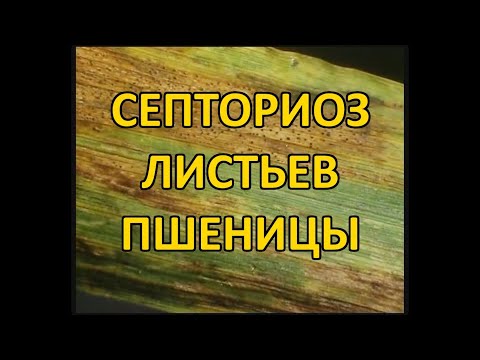

Watch this video on YouTube
Barley
The manifestation of white spot on barley is observed in the second half of the growing season. However, it also happens that the first signs of the disease appear already at seedlings. Symptoms of septoria on barley and wheat are the same, since it is caused in both cases by the same fungus. In the case of barley, the disease can affect both foliage and stems with ears. To combat white spot on cereals, only the preventive measures described in detail above are used.
Sunflower
After the sunflower is affected by white spot, its first symptoms can first be seen on the cotyledons, then irregularly shaped, rounded spots of yellow color (over time they become brown) appear on the lower leaf plates, and later on the upper ones. The spots appearing on the front surface of the leaves have a light edging, and the formations located on the seamy side have a grayish rim. Over time, dying off and loss of tissue located inside the spots is observed, as a result of which holes appear on the leaf plates. Sometimes the symptoms of septoria can be seen not only on the foliage, but also on the baskets and stems of the plant. The danger of this disease lies in the fact that it can only be dealt with by agrotechnical methods, which are described in detail in the section on wheat.


Watch this video on YouTube
Septoria tomato
Some garden crops, for example, tomatoes, are also affected by septoria. In this case, tomatoes grown in the open field are most often affected. However, seedlings can be affected by white spot, and bushes grown in the greenhouse also get sick with it. However, in greenhouse conditions, it is much easier to fight the disease, since it appears in the form of foci. In diseased plants, small dark spots saturated with moisture form on old leaf plates, much less often they appear on the petioles, fruits and sepals. Over time, the spots increase in size, and in diameter they can reach about 0.5 cm, a border of a dark shade forms around them, and the middle turns pale. Further, yellowing and dying off of diseased leaf plates is observed, which leads to a delay in the development of the bush, since it begins to spend part of its plastic substances on the formation and growth of new foliage. There are years in history when, due to the defeat of tomatoes by Septoria, gardeners lost up to half of the harvest.
After the first symptoms of the disease are found on the bushes, they are sprayed with Bordeaux mixture or its substitute (for example, Oxykh or HOM). Fungal agents such as Title, Revus and Thanos effectively fight septoria. But do not forget that for the reliable protection of this crop from septoria, one should not neglect preventive measures:
- in the autumn, the site is cleaned of plant residues, which are necessarily burned, and then a deep digging of the soil is carried out;
- it is recommended to plant tomatoes away from other plants, especially those that are susceptible to fungal diseases;
- timely disinfection of greenhouses, hotbeds, soil, garden tools, as well as planting or seed material is carried out;
- it is recommended to strictly adhere to the planting schemes, in this case, the required amount of fresh air will flow to each bush.
And experts also advise, for growing, choose those varieties of tomatoes that are highly resistant to white spot, for example: Platus, Mondial, Horev, Joker, Worthy, Ballada, Amiko, Golden Fleece, etc.
Septoria hydrangea
White spot can also appear on the foliage of ornamental shrubs, including hydrangeas. On the surface of the leaf plates, specks of brown color are formed, reaching a diameter of about 0.5 cm. As the disease progresses, the affected foliage flies around, and the hydrangea loses its decorative effect. After this, the disease spreads to young shoots. It is recommended to cut off diseased parts of the plant, and it is imperative to capture several centimeters of healthy tissue. After that, the bush is treated with Bordeaux liquid, Profit, or another agent containing copper. In the fall, remove all loose leaves and other plant debris and destroy them. Next, spray the hydrangea and the surface of the soil near it with a solution of Bordeaux mixture (1%) and dig the soil in the trunk circle. In the spring, before sap flow begins, the bush is again sprayed with Bordeaux mixture.
Preparations for septoria disease (fungicides)
Chemicals such as the following work best with white spotting:
- Hom... Systemic local drug containing copper. It is used to combat fungal diseases, for example: septoria, peronosporosis, scab, late blight, etc.
- Oxyhom... A broad-spectrum systemic contact agent containing copper is used to treat fungal diseases.
- Copper sulfate... This broad-spectrum contact agent is used to treat fungal diseases of berry, fruit and ornamental crops.
- inkstone... This drug is used to prevent and combat fungal diseases.
- Bordeaux liquid... This broad-spectrum copper-containing agent is used for the preventive treatment of fruit, citrus, ornamental, vegetable, berry, melon and flower crops against a number of diseases.
- Profit... Contact drug used to treat various fungal diseases, for example: septoriasis, alternoriasis, late blight, etc.
- Nitrofen... The product is used to fight mold, fungal and parasitic infections. It also helps to decontaminate the soil and curb the growth of weeds.
- Khomecin... The contact agent is used for protective purposes for spraying crops during the growing season.
- Captan... This remedy is used both for protection and for treatment of many crops, it can replace Bordeaux mixture.
- Phthalan... Such a drug has a wider spectrum of action than Captan.
For the treatment of white spot, the following agents are still used: Acrobat MC, Previkur, Ridomil Gold MC, Fundazol, Skor and Ordan. In this case, spraying for the purpose of prevention is carried out using drugs such as: Rovral, Trichodermin and Glyocladin. During the preparation of the solution for both therapeutic and prophylactic treatment, it is imperative to follow the manufacturer's instructions, which is on the package.
Folk remedies
In the fight against septoria, folk remedies in the form of infusions and decoctions have shown their low effectiveness. In this regard, in order to protect crops from this disease, as well as to avoid the use of toxic chemicals, experts advise not to forget about the preventive measures, which are described in detail above.

